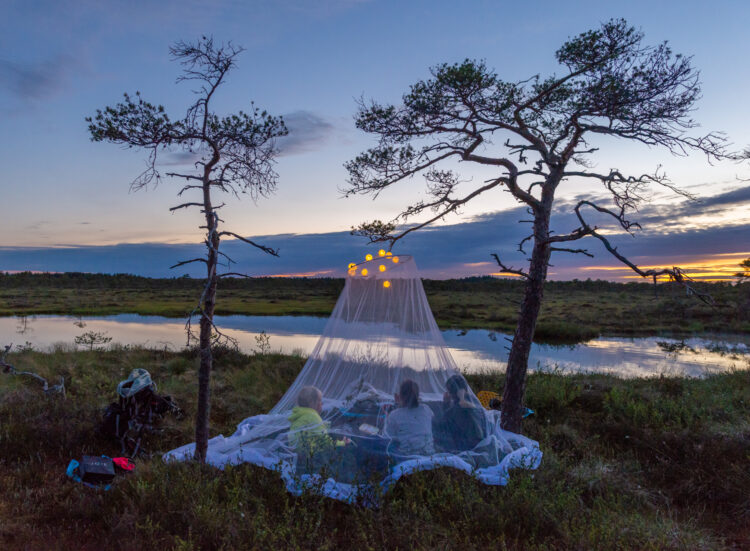Estonian bogs have gone through a large-scale transformation from being seen as a horrific place to becoming one of the most loved landscapes. Our bogs are the top-of-the-list attraction for every tourist willing to discover the Estonian countryside and wildlife.
To ensure you will get the best out of your bog experience, I will cover the following topics:
- What is a bog?
- The story behind Estonians and their bogs
- Ways to go to the bog (from Tallinn) and which bog to visit?
- The best time to visit the bog in Estonia: seasons
- Customized bog tours
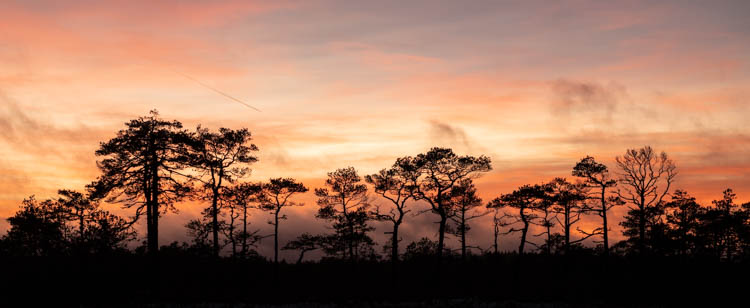

What is a bog?
The bog is the oldest organic landscape in Estonia, reaching in some cases up to 10 000 years of age. The first bogs started to emerge here right after the last ice age. As the 1km thick glacier ice sheet was melting towards the North pole, the meltwater as a leftover was collected in depressions previously created by the glacier ice.
Over the next thousands of years, plants grew and died within those shallow and oxygen-deprived meltwater lakes. As a result, the dead plant material didn’t become decomposed but rather created ever-lasting peat/turf and turned the water acidic. Every year, one layer of partially decomposed organic material is accumulated underneath the mossy surface of the bog and this effect has taken place since the very beginning!
In Estonian bogs, the pace at which the peat accumulates is roughly 1mm annually. In most Estonian bogs, the peat layer is 5-7 meters on average, which equals about 5000-7000 years of age. Over the course of thousands of years, this landscape goes through a series of transformations. At the very beginning, this peat accumulation landscape does not have a significant effect on plants – the peat layer is just too thin and flora is able to reach to the nutrient-rich groundwater. After millennia or two, the peat layer becomes thicker and filters out more demanding plants. The visual of the landscape is about to change. Birch trees will give up and pines will slowly start to take over. This middle stage is called transitional mire.
Later the peat layer gets just so thick that only the toughest plants will survive. The third stage is called bog or raised bog. Here you can see a lot of bog pools or lakes inside this huge organic sponge. The landscape is entirely independent, meaning that the plants don’t have access to nutrient-rich groundwater and all they have is rainwater stored in the ground. Bogs can be seen as huge sponges that can store huge amounts of water. Mainly because the sphagnum moss, also known as the “bog builder plant” is able to absorb almost 20x its body mass. So in some ways, bogs are also giant water reservoirs.
For visual understanding, see the video explaining the development of the bog:
Facts you should know about Estonian bogs:
- Oldest bogs are around 9000-10000 years old. The older bogs tend to be located at Southern regions because those spots were released by the glacier ice earlier. But that’s not a rule.
- The water in the bogs is acidic because of the sphagnum moss.
- Water is really pure and drinkable, but won’t take your thirst away (remember, no minerals/nutrients!)
- The acidic and oxygen-deprived environment in the ground preserves different objects really well, including tanks and human bodies.
- Some sources say that 22% or 1/5 of Estonia is covered with swamps and bogs. That’s not true. This number includes all the peat/turf areas, including exploited mining sites. The actual number is somewhere around 6-7%. Most of those landscapes were destroyed by the Soviet Union.
- In the past, local people have been afraid of bogs. Estonian folklore has a lot of associations with the bog or swamp-related phenomena.
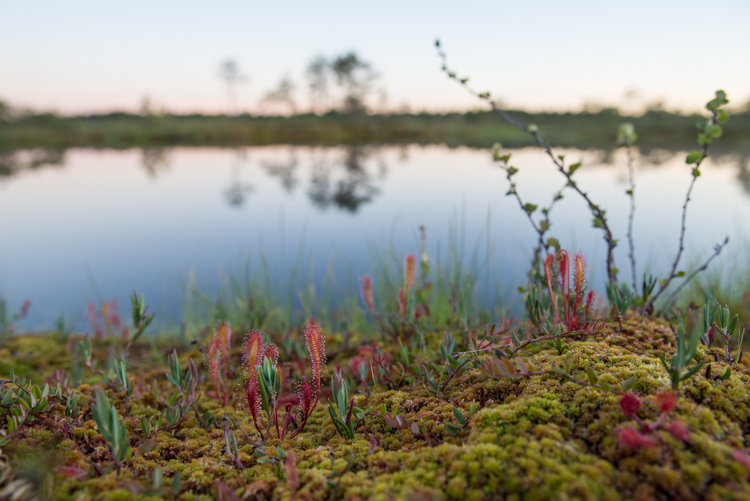

The story behind Estonians and their bogs
The oldest human settlement in Estonia is the Pulli village or Pulli settlement in South-West Estonia. Scientists believe it to be somewhere between 10 000 – 11 000 years old. As said earlier, the oldest bogs are also 10 000 years old. So it appears that people here have been developing together with the landscape, which is not very common in other parts of the world.
Estonians have seen the rise of the first bogs as well as the birth of the forests. This could be the reason why we have so strong bond to our nature. It’s reflected in our culture as well. For example, we have a disproportional amount of words describing natural sounds (wind and water). Although we have the longest relationship with bogs, it has been anything but stable. Interestingly enough, the perception of bogs among local people has been in constant change. The way people see the bog today was unheard of 100 years ago.
Bog as a source of food
In the very beginning, before the mosses took over the shallow meltwater lakes, our forefathers used those areas as a water path to navigate from one place to another. Remember – the ice age had just ended and a significant part of Estonia was below water level. In the next few thousand years, the plants took over and started to form this spongy ever-growing peat layer.
It appears that as the water areas turned into this weird hybrid landscape and people started to avoid it. Mostly because it was easy to sink in and getting through the bog was real challenges. Besides physical difficulty, this homogeneous landscape was tough to navigate. Everything looked very similar and there were no pinpoints to rely on.
One of the few people who visited bogs back then were hunters. It might be surprising, but the heaviest animal in Estonia – a moose – prefers to use swamps and bogs as its habitat. Open field and challenging terrain provide it space and shelter. Besides moose, different species of grouse prefer to live in this wetland as well. So those early tribes of hunter-gatherers had to find their way to bogs. According to the findings of Pulli settlement, those early tribes hunted mostly beavers and moose. Hunting was men’s duty, so we can assume that a significant part of those early communities didn’t get to experience bogs at all. They just had to rely on the stories of others.
Bog as refuge
Estonians lived as pagans up until the 13th century when a huge campaign was organized by Swedes, Danes, and Germans to conquer the Eastern region of the Baltic Sea and to bring Christianity along.
Historians claim that at the time, the Estonian strongholds provided shelter to 6-9% of the entire population. As a result, 90+% of the Estonians had to rely on natural refuges. What place could be better to hide than the bog? Difficult terrain, easy to sink in (especially with horses and heavy artillery), easy to get lost… Suddenly, terrifying bog turned into a shelter. The perception had changed.
You may wonder where could people hide in an open space. The answer is bog islands. Bog island is a hill, that rises above the mossy surface of the bog. This hill consists of gravel, sand, etc. and is basically a mineral land. Therefore it’s like an oasis in the desert. Usually, bog island is covered with tall forest and provides a way more food than the bog.
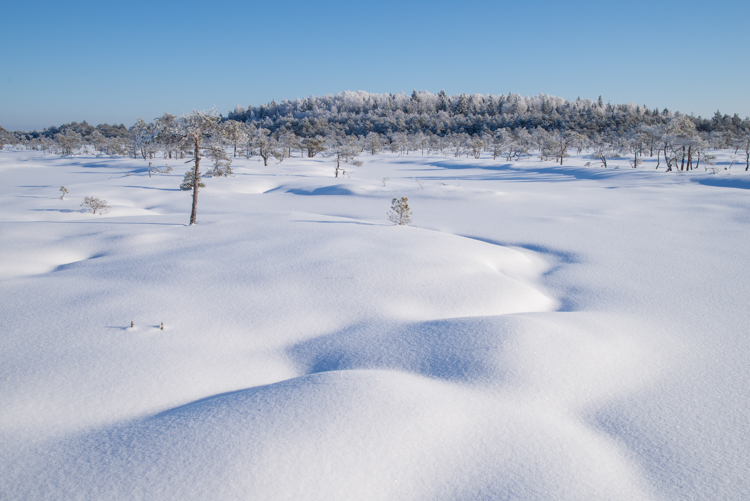

Bog as a resource (to exploit)
Over the next few hundred years, Estonians were turned into Christians (as many other nations at the East coast of the Baltic sea) and they became slaves. Their landlords built castles and manors and Estonians served the needs of those foreign families as peasants.
While the pagans saw nature as something above the human being, the foreign regime decided to start exploiting local forests and bogs. People started digging the ditches to drain the bogs and as a result, they were able to dig the peat and make bricks out of it. Manors used those bricks for heating purposes to produce vodka.
Since the tools and machinery were relatively primitive at the time, it didn’t cause too many problems for Estonian bogs. But the most difficult times for our wetlands had arrived on the horizon.
In 1940 Estonia was occupied by the Soviet Union. With its heavy machinery and the need for resources, the Soviet regime decided to start large-scale draining in our wetlands. The idea was to create more farmland at the expense of bogs and swamps and to boost the growth rate of forests surrounding the wetlands. Roughly 2/3 of our peatlands (both bogs and swamps) were damaged.
The situation got worse until somewhere in the 1970s a group of activists started to raise the awareness around swamps and bogs. This period is also called “war about mires” (mire is a scientific term for the swamp). Their purpose was to acknowledge the fact that bogs can offer us something much more than just physical resources. Bog operates as a carbon sink and therefore mitigates the effects of climate change. And as we know today, it’s a perfect place for aesthetic experiences. In my opinion, Estonian bogs are like the last refuge for all the people interested in plugging themselves out of the overwhelming noise.
This movement in the 1970s-1980s was successful enough to influence the Soviet regime to start declaring bigger bogs as protected areas. In this sense, we Estonians cannot take bogs for granted. We could have easily lost this unique landscape many decades ago as it has happened in other parts of the world.
Bog as a place to restore yourself mentally and physically
Since the Estonian bogs were “rebranded” decades ago, their popularity has skyrocketed. The State Forestry Agency has built a lot of boardwalks and forest trails to provide easier access to all the people interested in enjoying the silence and minimalistic landscapes.
Suddenly, bogs have become the symbols of our country. 100 years ago it was unheard of to say, think or write anything pleasant about our swamps or bogs. Today, people still have some sort of unconscious “itch” inside them when they get off the trails and feel this spongy ground. But walking on boardwalks has become so popular, that on the weekends you could encounter more people in bog than in a shopping mall. So if interested in peace and silence, you have to choose your destinations carefully.
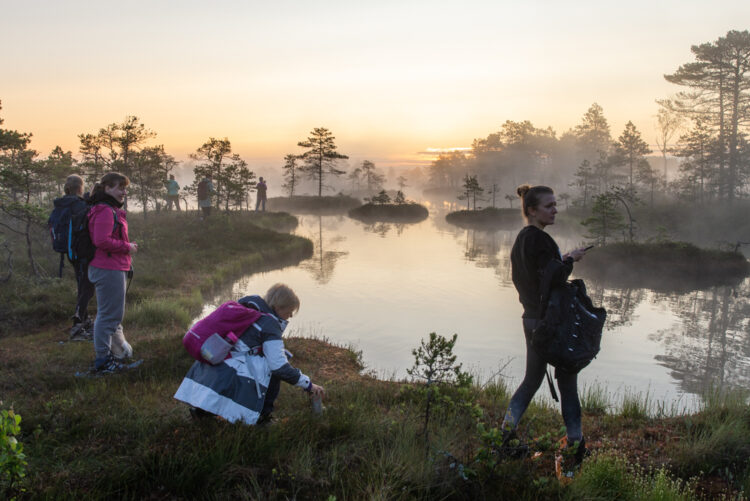

Ways to go to the bog (from Tallinn) and which bog to visit?
It takes about a 1-hour drive from Tallinn to end up in a bog. The most marketed bog in Estonia is without a doubt Viru bog. It’s close to the capital, very easily accessible and offers you a chance to take a look at the bog from the watchtower as well. BUT keep in mind that on a sunny weekend it’s tough to enjoy anything besides crowded boardwalk. Last time I was there I counted roughly 150 cars in a parking lot. 150!
In general, you have two options to experience an Estonian bog: 1) to join a day trip from Tallinn; 2) to rent a car and enjoy the freedom to discover everything just as much as you prefer to. If you prefer convenience over experience, you can probably find the right tour from TripAdvisor.
If you’re more into adventures and getting the most out of your trip, I really suggest you rent a car or a car with a driver if needed. Renting a car in Tallinn is super easy and all you have to do is drive. 🙂
Let’s assume you just got the car and now it’s time to pick a destination. I will lay out 5 bog trails worth visiting besides Viru bog.
- Majakivi-Pikanõmme nature trail (7km) is a great alternative to often crowded Viru bog. It’s located in Lahemaa National Park and there is a watchtower on this bog trail as well. I think it’s a reasonable pick when interested in a well-rounded road trip. See the captain villages, enjoy local restaurants and experience the bog.
- Kakerdaja nature trail (7km) is probably the second most popular bog in Estonia. Fortunately, it’s many times behind Viru bog and therefore you have much more room experience the tranquility of this ancient landscape. There is an official swimming spot as well, so take your towel with you and enjoy the soft and very skin-friendly dark water.
- Kõnnu Suursoo bog. By clicking on the name you will get the very exact spot where to leave your car and continue down the path from there on. You will soon see a small lake and be sure to take your steps to the right until you reach the boardwalk. Kõnnu Suursoo bog is one of the best bogs to watch the sunrise. There are two watchtowers: one smaller in the bog and a bigger tower on the hill on the other side of the bog.
- Loosalu nature trail (7.7km). About a 1-hour drive to South from Tallinn. In this bog, you will see the biggest bog lake in Estonia – lake Loosalu. After bog tour, consider visiting a local restaurant, which continues to be among the best places to eat in Estonia – Ööbiku Gastronomy Farm.
- Mukri bog is a very “compact” bog and reachable in a 1h 20min drive from Tallinn. It’s located in Rapla county and although the trail is just 2.5km, you will get to see beautiful bog lakes and also walk up to the watchtower to take a broader look at this minimalistic landscape. There is also a camping site with a dry closet right next to the parking lot, so you can set up a campfire (firewood is for free!) and enjoy your meal. It’s a great stop when heading from Pärnu to Tallinn or vice versa. PS! There are also two official swimming spots in the bog!
The best time to visit the bog in Estonia: seasons
As you may guess, every season has its pros and cons. Although I see some benefits visiting bogs in particular time periods, I still think everything depends on your goals. Is it to see wildlife? To swim in a bog lake? To pick berries? To skate on the frozen lakes?
Spring
Spring (March-May) is probably the best period to encounter birds and animals. For example, male black grouses are having battles in the bogs at the sunrise. Of course, it’s something that needs preparation and setting up a hide to witness those rare moments. The cranes are arriving from Africa and many birds are stopping by to continue their journey to polar regions. Many plants, including mystical labrador tea, bloom in May-June. I love spring because at that time we don’t have mosquitoes here. 🙂


Summer
In Estonian, we have some relatedness between the words “bog” and “desert”. Although it’s a wetland, it has indeed something that reminds desert. First, it’s probably one of the most silent landscapes in Estonia. Compared to forests, there are a lot fewer species that are able to survive in the nutrient-poor conditions of the bog. But the number one thing is how both landscapes react to temperature/weather. I don’t suggest going to the bog in the hot summer days – because of the dark ground, it gets really hot and there is nowhere to hide from the direct sunlight + you potentially have to deal with horseflies. In the summer, the best time going to the bog is right before sunset or sunrise. You will then have the least problems with insects + the view is magical. Especially when the sky is clear. AND you can enjoy the water that feels especially warm when the air temperature starts to drop.
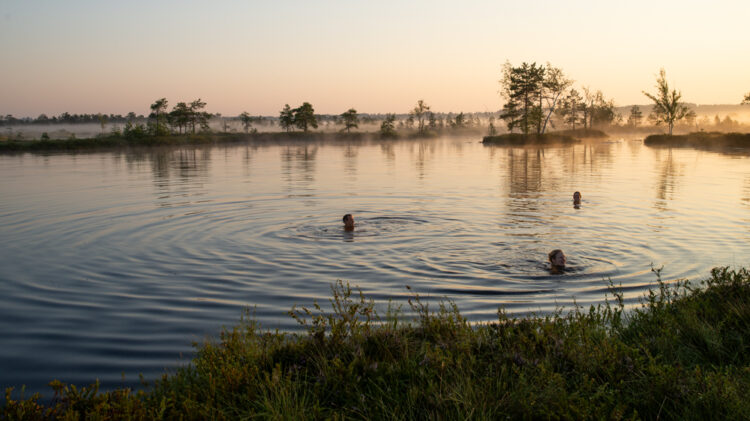

Autumn
Autumn is my absolute favorite. August-September-October. Starry skies, misty mornings. Berries – blueberries, lingonberries, bilberries, cranberries, and cloudberries. Mushrooms! Chanterelles! In the autumn, the mosses covering the ground turn into colorful “carpet” + you’ll see the yellow-red colored trees on the horizon. Perfect time for camping and staying overnight as well.
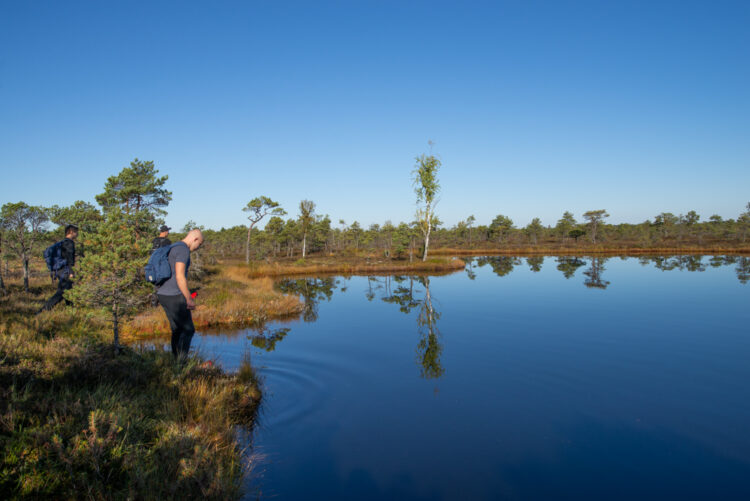

Winter
Well…With winter it can go both ways – you either have snow in Estonia or you don’t. When you do, you can go skating on bog lakes, hike with snowshoes on over the frozen lakes, make a fire, camp either in a hammock or in a glamping tent. Catch fish on the ice. Fullmoon hike on glowing white snow? No mosquitoes, no crowded camping sites. Silence!
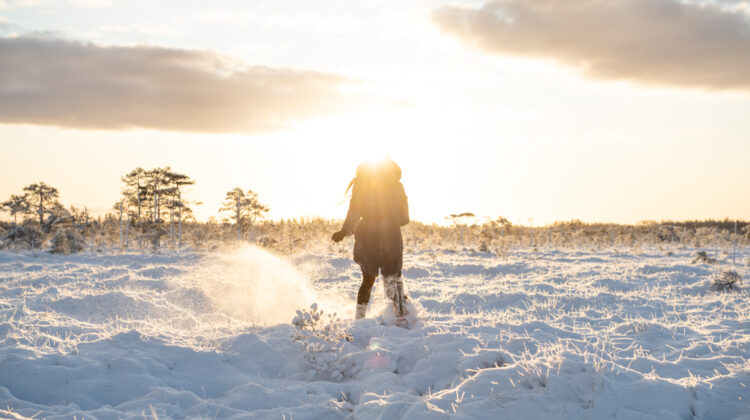

Customized bog tours
If you’d like to get a better glimpse of it and are willing to invest more time than just a few hours or half a day, I suggest you come and stay overnight. If sleeping in a hammock feels too extreme, we can sleep in a glamping tent that has stove inside as well. I’ve written about overnight tours HERE.
I’m very flexible in terms of the time and duration of the tour. We have lots of great spots all over Estonia. The closest places to Tallinn are located in Harju county and Rapla county (roughly in 50-70km range). If you’re up for a serious bog adventure, you should take a few days I will organize a small trip to Alutaguse Nationalpark – a huge area of swamps and bogs right next to the Russian border. To the North from Lake Peipus.
Remember – I’m always willing to help you if you have concerns or questions regarding Estonian bogs. You can contact me via e-mail or Instagram (@metaloodus).
Take care!
Romet Vaino

